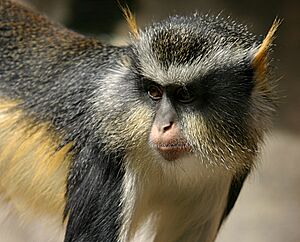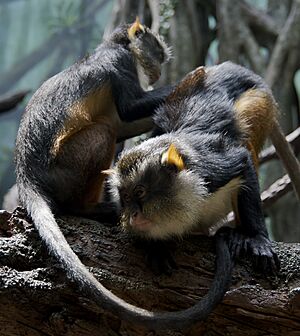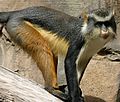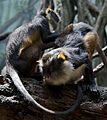Wolf's mona monkey facts for kids
Quick facts for kids Wolf's mona monkey |
|
|---|---|
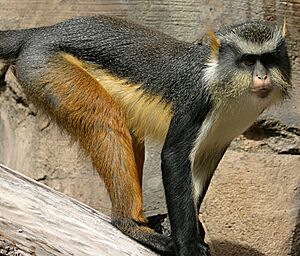 |
|
| Wolf's mona monkey at the Henry Doorly Zoo | |
| Conservation status | |
| Scientific classification | |
| Genus: |
Cercopithecus
|
| Species: |
wolfi
|
The Wolf's mona monkey (also known as Wolf's guenon) is a very colorful monkey from central Africa. It belongs to a group called Old World monkeys. You can mostly find these monkeys in countries like the Democratic Republic of the Congo and Uganda. They love living in thick lowland rainforests and swampy forests.
Contents
Discovering the Wolf's Mona Monkey
This amazing monkey was first described by scientists from a living monkey in a zoo in Dresden, Germany. It arrived there in 1887, brought by a Dr. Ludwig Wolf from central west Africa. Because of him, the monkey was named "Wolf's mona monkey" in 1891. The monkey sadly passed away in 1891, and its bones were studied a few years later.
Wolf's mona monkey is part of a group of monkeys called C. mona. This group includes other cool monkeys like the Campbell's mona monkey and the mona monkey. All these monkeys are part of a bigger family called Cercopithecus. Monkeys in this family, along with baboons and macaques, have special features. They have cheek pouches to store food and simple stomachs. These features help them eat lots of fruit!
There are two types, or subspecies, of Wolf's mona monkey. They live in different areas, separated by a big swampy forest:
- C. wolfi wolfi: You can find this type between the Congo and Sankuru Rivers.
- C. wolfi elegans: This type lives between the Lomami and Lualaba Rivers.
What Does a Wolf's Mona Monkey Look Like?
Guenons, which are a big group of African primates, are known for being very colorful. Their bright colors help them recognize each other, find mates, and tell different species apart. The Wolf's mona monkey is mostly dark grey with a reddish-brown patch on its back, like a "saddle."
The exact colors depend on which subspecies it is:
- C. wolfi wolfi has a chestnut-colored patch in the middle of its back. Its arms are black, and its legs are red. Its belly is yellow, sometimes with an orange stripe. Its cheek fur is yellow with black spots, and its ear tufts are red.
- C. wolfi elegans has a back that gets browner towards its rear. Its lower arms are black, and its upper arms have pale spots. Its legs are light gray, and its belly is white. Its cheek fur is white with dark spots, and its ear tufts are white.
Male Wolf's mona monkeys have bright blue private parts! Males are also much bigger than females. Males weigh about 4.5 kilograms (10 pounds), while females weigh about 2.5 kilograms (5.5 pounds). Because they are small, they can be hunted by predators like the crowned eagle and the leopard.
How Wolf's Mona Monkeys Behave
What Do Wolf's Mona Monkeys Eat?
Wolf's mona monkeys mostly eat fruit. But they also look for seeds and insects to get protein. They don't have special body parts for eating leaves, so they usually only eat young, soft leaves that are easy to digest. Their diet can change depending on where they live.
Monkey Family Life
Wolf's mona monkeys usually have their babies between June and December. This is because there's more rain and food available then. They live in groups with one male and several females. The females tend to stay with their birth group, but the males leave when they grow up. Since one male is in charge of many females, there's a lot of competition to be the main male.
Female monkeys are usually friendly with each other. They often groom each other, which means cleaning their fur. They also help take care of each other's babies. Unlike some other monkeys, they don't have a strict pecking order.
Different groups of Wolf's mona monkeys usually don't like each other. Both males and females can act aggressively when they meet another group. They are very protective of their home area. They use loud calls and sometimes even fight to defend their territory. Females are important in defending their space; when they call out, it makes the male call too.
These monkeys have very developed cheek pouches, which are like little bags inside their cheeks. They use these pouches to store food while they are gathering it. This might help them when they are with other monkey species, so they can quickly grab food before others do.
Monkey Friendships: Associations with Other Animals
Wolf's mona monkeys often hang out with other types of monkeys and even other animals like the bonobo. They don't have babies with these other species.
In one study, Wolf's mona monkeys were seen with bonobos. They would stay together for about 20 minutes on average, sometimes even over an hour! The monkeys usually started and ended these meetings, which suggests they got the most benefit from being together. Unlike common chimpanzees, bonobos usually don't hunt monkeys. No fights happened between the monkeys and bonobos during this study.
Another monkey, the red-tailed monkey, also associated with bonobos. Sometimes, a mixed group of Wolf's mona monkeys and red-tailed monkeys would join the bonobos. These mixed-group meetings always lasted for more than an hour. The monkeys mainly associated with bonobos when the bonobos were eating or resting. Wolf's mona monkeys would feed in the trees while the bonobos were below.
However, another study showed that bonobos *do* sometimes hunt monkeys, including Wolf's mona monkeys. In one five-year study, bonobos were seen hunting monkeys five times. This hunting seemed planned, with groups of bonobos working together. This is different from their usual hunting style, which is more solitary. In three cases, they successfully caught baby monkeys, including two Wolf's mona monkeys.
When different monkey species hang out together, they usually need to eat different things or feed at different heights in the trees to avoid competing for food. When in a mixed group, Wolf's mona monkeys usually feed at about 17 meters (56 feet) high. They often associate with red-tailed monkeys (who feed at 12 meters or 39 feet) and black crested mangabeys (who feed at 21.5 meters or 70 feet). These mixed groups probably form to help each other spot predators.
Images for kids



